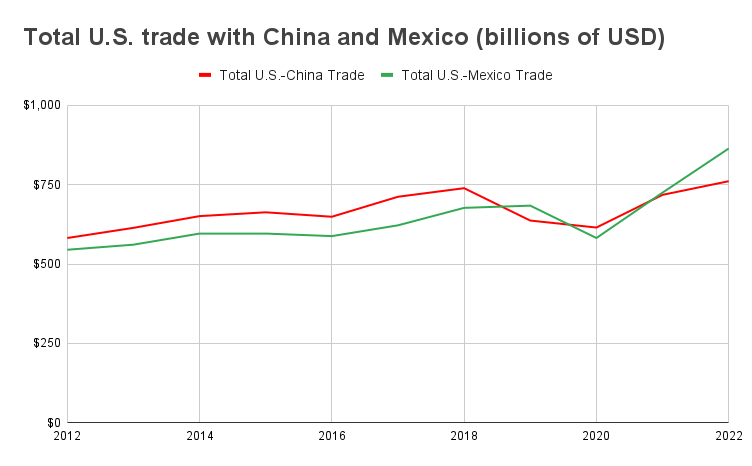U.S.-Mexico: A Special Partnership with Room for Growth
By Jacob Berch, CRA Trade and Economic Policy Intern, Fall 2023

In the face of rising global instability, it is vital that the United States and Mexico promote a civil, stable, and rules-based bilateral relationship. The two nations’ shared border, along with their rich cultural and trade ties, underscores the need for tactful diplomacy from both sides. Furthermore, escalating political risk overseas creates an opportunity for the neighbors to mutually ensure one another’s economic security.
Economic interdependence between the U.S. and Mexico has grown substantially in recent years, with Mexico now surpassing China in total trade volume with the U.S. The latest data from 2023 shows that the U.S. relies on Mexico as its largest trading partner, accounting for over 15% of total U.S. trade. Mexico’s dependence on the U.S. as a trading partner is even starker, with the U.S. accounting for about 83% of Mexican exports and about 43% of Mexican imports.
Although many industries are beneficiaries of this robust trading relationship, the agriculture sector in the U.S. is particularly reliant on it. For instance, Mexico is the number one importer of U.S. corn and a top importer of many refined corn products. Corn is just one example of numerous agricultural products from the U.S. that depend on the Mexican market – the second-largest foreign market for the sector.

The strength of this trading relationship can be owed in part to the countries’ geographic proximity, but also to the U.S.-Mexico-Canada Free Trade Agreement (USMCA) and its predecessor, the North American Free Trade Agreement (NAFTA). These comprehensive, rules-based trade agreements have promoted both nations’ competitiveness globally and ensured fair transnational competition. Without these free trade agreements, regional trade between the U.S. and Mexico, and the mutual economic benefit derived from this trade, would be nowhere near the volume it is at today.
Economic and trade ties are just one dimension of the deep connection between the U.S. and Mexico. The nations’ cultures are also closely interlinked. Spanish is firmly cemented as the second most spoken language in the U.S. What’s more, there are over 40 million citizens in the U.S. of Mexican descent. The countries share interwoven faiths, holidays, cuisine, and countless other commonalities. The ample cultural ties between the U.S. and Mexico both necessitate and facilitate thoughtful diplomatic engagement.
These steadfast economic and cultural connections between the U.S. and Mexico provide a solid foundation for both countries to support each other in navigating an increasingly unstable world. Geopolitical analysts have highlighted this opportunity, dubbing it ally-shoring. Mounting crises overseas, coupled with a more unpredictable U.S.-China relationship, leaves the U.S. and Mexico in a prime position to lean on each other to secure one another’s interests. The countries’ geographic closeness and already interdependent relationship make the concept of ally-shoring particularly appealing in this case.
Given broader geopolitical disorder and the strongly intertwined nature of Mexican and American societies, it is as crucial as ever that leaders in both countries engage in a considerate and diplomatic manner. There is a unique opportunity to take this special partnership to new heights – but only through dedicated and careful cooperation.